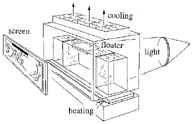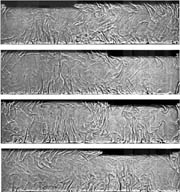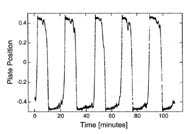|
Free Boundary Oscillations in Thermal Turbulence
|
|||||
| In 1966, Wilson asked an intriguing question:
"Did the Atlantic close and then reopen?" [Nature 211, 676, 1966].
There is considerable evidence that the Atlantic Ocean has closed and reopened
about 4-5 times in the past two billion years, with a period of about 300-500
million years. This period is now called the "Wilson cycle".
Our experiment demonstrates that in a turbulent state, Ra=10(7-8), a periodic state can develop through a thermal feedback mechanism. The floating continents behave like "thermal blankets", inducing dramatic changes in the convection pattern. The modified flow pattern in turn moves the continents to new positions. This two-way feedback mechanism is the key to the unforced free oscillation. This experiment was carried out at Rockefeller University in collaboration with Albert Libchaber. [Periodic boundary motion in thermal turbulence, by Jun Zhang and A. Libchaber, Physical Review Letters, 84, 4361, (2000) ] |
|||||
|
|||||
|
|
|||||



